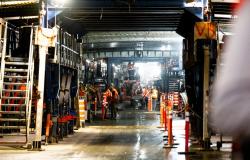A mysterious crash on the Moon continues to raise questions after a Chinese Chang’e 5-T1 rocket booster crashed on the surface. Follow-up observations would indeed have revealed not one, but two equivalent craters.
A double crater that questions
On March 4, 2022, an object initially identified as the booster of a SpaceX Falcon 9 rocket, abandoned in orbit in 2015, crashed on the Moon. Further investigation has since revealed that it was actually a rocket booster from China’s lunar exploration program, launched in 2014.
For seven years, a group of researchers from the University of Arizona had in fact followed the trajectory of the space object. In a recently published article, they explained that they had examined the light reflection signature of the rocket as well as its movements in space. Based on the observed characteristics, they concluded that the object was likely the Chinese mission booster Chang’e 5-T1.
However, an intriguing revelation occurred: this booster carried a mysterious payload which also disappeared during the impact on the lunar surface, as evidenced by the presence of two craters on the surface. However, according to Tanner Campbell, a doctoral student at the University of Arizona, to obtain these two craters of approximately the same size, you need two approximately equal masses.
A surprisingly stable object
Observations made with the telescope revealed the unique behavior of the booster. Considering the gravitational forces of the Earth and the Moon, as well as the continued exposure to sunlight over time in space, this booster should indeed have oscillated during its lunar approach, especially given the asymmetrical structure of the rocket with an empty hull and a heavy engine on one side. Instead, the booster would ultimately have “stayed the course” from one end to the other, demonstrating a remarkable stability.
The researchers therefore hypothesized that an additional element was attached to the front of the thruster, acting as a counterweight to both engines and now stability in orbit. When the booster crashed into the Moon, the two resulting craters reinforced their theory. The exact nature of this element, however, remains unknown. This could be an additional support structure, specific instruments or something else. Unfortunately, it is unlikely that this information will ever be revealed. With future lunar missions planned, however, it will be wise to advocate for greater transparency regarding objects deployed by space agencies and other industry players.
The mysterious crash of the Chang’e 5-T1 mission’s booster on the Moon raises many questions that remain unanswered. The formation of two craters of equivalent size, as well as the unexpected stability of the approaching object, suggest the presence of an additional element attached to the thruster, the nature of which remains unknown. This phenomenon intrigues researchers and highlights the importance of greater transparency in space missions, particularly regarding objects deployed in orbit. As lunar exploration continues, it becomes essential to fully understand the implications of these mysterious events to better anticipate future challenges in space exploration.
Could analysis of impacted debris reveal hidden clues?
Although the craters left by the impact have sparked much speculation, some scientists believe that studying the debris ejected during the collision could provide additional information. This debris could contain fragments of as-yet-unknown materials or specific components associated with the booster’s mysterious payload. Remote analysis techniques, such as spectrometry, could thus be used to better understand the composition of the craters and potentially discover the nature of the unidentified object. This hypothesis fuels the debate on the need for robotic or human missions to more closely inspect these lunar impact sites.





